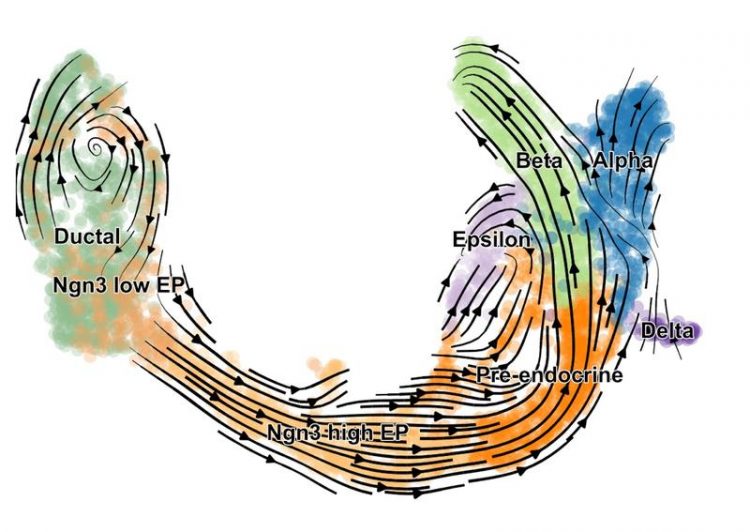AI & single-cell genomics

scVelo reveals fine-grained insights into the developmental processes in the pancreas. Credit: Helmholtz Zentrum München
Traditional single-cell sequencing methods help to reveal insights about cellular differences and functions – but they do this with static snapshots only rather than time-lapse films.
This limitation makes it difficult to draw conclusions about the dynamics of cell development and gene activity. The recently introduced method “RNA velocity” aims to reconstruct the developmental trajectory of a cell on a computational basis (leveraging ratios of unspliced and spliced transcripts).
This method, however, is applicable to steady-state populations only. Researchers were therefore looking for ways to extend the concept of RNA velocity to dynamic populations which are of crucial importance to understand cell development and disease response.
Single-cell velocity
Researchers from the Institute of Computational Biology at Helmholtz Zentrum München and the Department of Mathematics at TUM developed “scVelo” (single-cell velocity).
The method estimates RNA velocity with an AI-based model by solving the full gene-wise transcriptional dynamics. This allows them to generalize the concept of RNA velocity to a wide variety of biological systems including dynamic populations.
“We have used scVelo to reveal cell development in the endocrine pancreas, in the hippocampus, and to study dynamic processes in lung regeneration – and this is just the beginning”, says Volker Bergen, main creator of scVelo and first author of the corresponding study in Nature Biotechnology.
With scVelo researchers can estimate reaction rates of RNA transcription, splicing and degradation without the need of any experimental data. These rates can help to better understand the cell identity and phenotypic heterogeneity.
Their introduction of a latent time reconstructs the unknown developmental time to position the cells along the trajectory of the underlying biological process. That is particularly useful to better understand cellular decision making.
Moreover, scVelo reveals regulatory changes and putative driver genes therein. This helps to understand not only how but also why cells are developing the way they do.
Empowering personalized treatments
AI-based tools like scVelo give rise to personalized treatments. Going from static snapshots to full dynamics allows researchers to move from descriptive towards predictive models.
In the future, this might help to better understand disease progression such as tumor formation, or to unravel cell signaling in response to cancer treatment.
“scVelo has been downloaded almost 60.000 times since its release last year. It has become a stepping-stone tooltowards the kinetic foundation for single-cell transcriptomics”, adds Prof. Fabian Theis, who conceived the study and serves as Director at the Institute for Computational Biology at Helmholtz Zentrums München and Chair for Mathematical Modeling of Biological Systems at TUM.
Media Contact
More Information:
http://dx.doi.org/10.1038/s41587-020-0591-3All latest news from the category: Life Sciences and Chemistry
Articles and reports from the Life Sciences and chemistry area deal with applied and basic research into modern biology, chemistry and human medicine.
Valuable information can be found on a range of life sciences fields including bacteriology, biochemistry, bionics, bioinformatics, biophysics, biotechnology, genetics, geobotany, human biology, marine biology, microbiology, molecular biology, cellular biology, zoology, bioinorganic chemistry, microchemistry and environmental chemistry.
Newest articles

Pinpointing hydrogen isotopes in titanium hydride nanofilms
Although it is the smallest and lightest atom, hydrogen can have a big impact by infiltrating other materials and affecting their properties, such as superconductivity and metal-insulator-transitions. Now, researchers from…

A new way of entangling light and sound
For a wide variety of emerging quantum technologies, such as secure quantum communications and quantum computing, quantum entanglement is a prerequisite. Scientists at the Max-Planck-Institute for the Science of Light…

Telescope for NASA’s Roman Mission complete, delivered to Goddard
NASA’s Nancy Grace Roman Space Telescope is one giant step closer to unlocking the mysteries of the universe. The mission has now received its final major delivery: the Optical Telescope…



